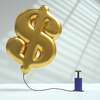
The Fed’s historic series of rate hikes over the past year has also pushed interest rates on high-yield savings accounts to their highest levels in 15 years.
Andriy Onufriyenko/Getty ImagesEven as inflation moderated for a seventh straight month, it isn’t slowing as quickly as expected, according to the January Consumer Price Index released February 14. It’s a sour turn just two weeks after the Federal Reserve’s optimistic update, which left many believing only a few more rate hikes would be necessary to fully tame the situation. However, the costs for basic goods and services rose 6.4% from the previous year — just 0.1% less than in December and still well above the Fed’s 2% goal.
What’s more, after stripping volatile measures like food and fuel prices from the mix, the rate of inflation on “core” goods and services stayed the same between December and January. Some economists believe that’s a worrisome sign that inflation will persist long into 2023.
But the news isn’t all grim. The Fed’s historic series of rate hikes over the past year has also pushed interest rates on high-yield savings accounts to their highest levels in 15 years. Returns on the best yielding accounts are generally above 4%, while one account has even topped 5%. So one simple way to combat rising inflation: Shop around for a better interest rate on your savings account. Here’s what to know.
The relationship between Fed rate hikes, inflation, and your savings
The Fed raised its benchmark interest rate by 0.25% on February 1 — its eighth consecutive rate increase in its efforts to cool inflation. Even though the Fed doesn’t control savings account interest rates, its actions influence them, and the rates typically rise in tandem. As of February 1, the national average interest rate for savings accounts is 0.23%, consistent with recent trends, according to Bankrate’s weekly survey.
The connection between Federal interest rates and savings account interest rates hasn’t been as strong ever since the 2008 financial crisis. Interest on savings accounts has risen more slowly this past year than conventional wisdom would suggest. But it’s still more than tripled since the Fed started its push in March 2022.
Some economists predict that banks will soon start raising savings account interest rates more rapidly, as the gap between the Fed’s rate and interest rates on savings accounts grows. The bigger the gap, the more pressure banks feel to catch up. And once some banks start raising rates, it leads to a ripple effect among others competing for your deposits.
People are finding the best returns at online banks, versus traditional brick-and-mortar banks — in some cases as much as 10 times higher. Yet most high-yield savings accounts offer the same flexibility as traditional savings accounts, such as the ability to easily transfer money to a checking account. Certificates of deposit, or CDs, are also a good option for higher interest rates, especially if you plan to leave your money in place for a while.
How a high-yield savings account works
High-yield savings accounts function much like a traditional savings account. Money that you deposit earns interest, also called the annual percentage yield, or APY. That interest can also be compounded, which means that over time, you earn interest on the interest that’s been added to your account. (Worth noting: Interest rates on savings accounts aren’t fixed, so ones that are up now could eventually go down.)
The primary difference between a high-yield savings account and a traditional account is the amount of interest you can earn. Online banks, which tend to offer the best interest rates, don’t have the same overhead as brick-and-mortar banks. They pass that savings on to customers in the form of higher interest rates. As long as the bank is FDIC insured, it doesn’t matter if it’s a traditional bank or online bank; your money is protected up to $250,000 per depositor, per account type. (Use the FDIC BankFind tool to check.)
Just like traditional savings accounts, some high-yield savings accounts require a minimum balance in order to earn interest or avoid fees. You may also find a limit to the number of withdrawals you can make each month. However, you can add as much money as you want, whenever you want.
Interest rates are one of the best tools banks have for gaining new customers. If the Fed continues raising the interest rate at the central bank, as expected, it will likely make that competition even more intense. So while it might sound intimidating or time-consuming to research interest rates and switch banks, the payoff for your savings could be big.
Where’s inflation headed next?
Based on the recent price data and a surprisingly strong January jobs report, some experts now believe there’s much more work to go in the fight against inflation. Unemployment fell to 3.4% in January, the lowest it’s been since 1969. That’s great news for workers, of course. But it’s a sign to the Fed that it might be necessary to push the benchmark borrowing rate above 5% before inflation fully eases.
Powell struck a moderate tone February 7 at an event at the Economic Club of Washington, DC, a week before the latest consumer price data release. “There has been an expectation that [inflation] will go away quickly and painlessly — and I don’t think that’s at all guaranteed; that’s not the base case,” he said. “The base case for me is that it will take some time, and we’ll have to do more rate increases, and then we’ll have to look around and see whether we’ve done enough.”
So what’s that mean for your money? More rate hikes from the Fed will likely push interest rates on high-yield savings accounts even higher. As inflation continues to push up the cost of living, it’s more important than ever to make sure your money is positioned to work as hard for you as possible.
Editorial Disclosure: All articles are prepared by editorial staff and contributors. Opinions expressed therein are solely those of the editorial team and have not been reviewed or approved by any advertiser. The information, including rates and fees, presented in this article is accurate as of the date of the publish. Check the lender’s website for the most current information.
This article was originally published on SFGate.com and reviewed by Jill Slattery, who serves as VP of Content for the Hearst E-Commerce team. Email her at jill.slattery@hearst.com.














